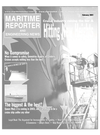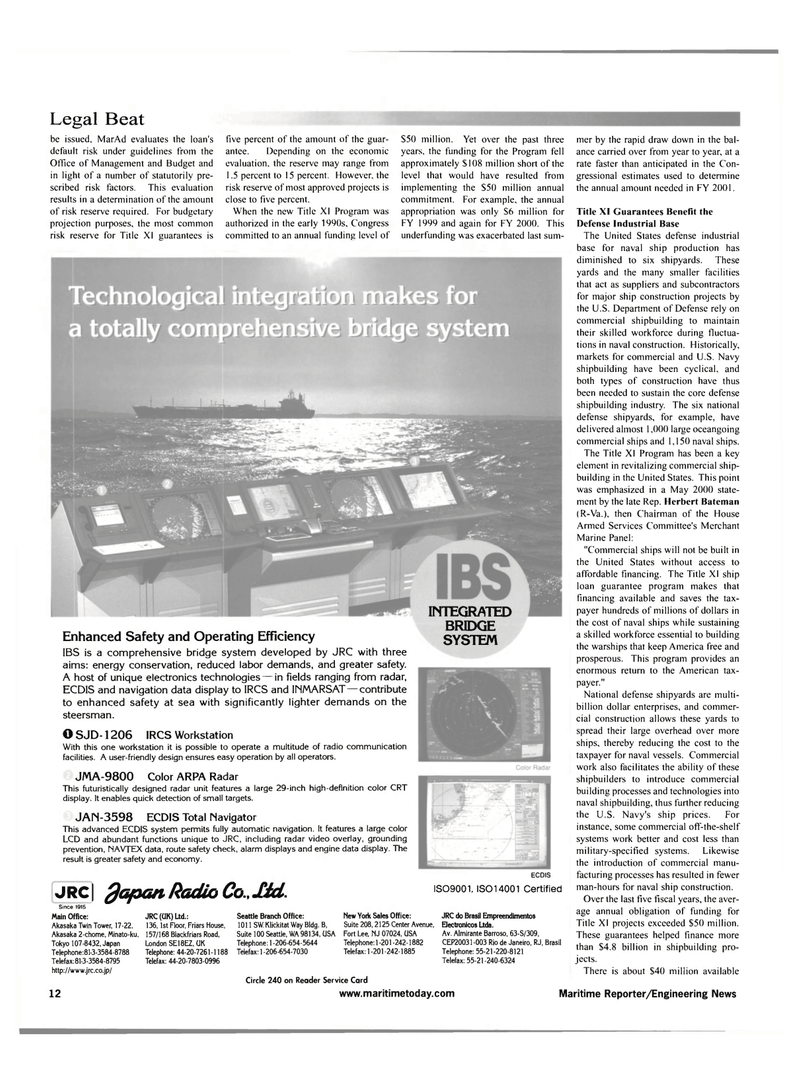
Page 12: of Maritime Reporter Magazine (February 2001)
Read this page in Pdf, Flash or Html5 edition of February 2001 Maritime Reporter Magazine
Legal Beat be issued, MarAd evaluates the loan's default risk under guidelines from the
Office of Management and Budget and in light of a number of statutorily pre- scribed risk factors. This evaluation results in a determination of the amount of risk reserve required. For budgetary projection purposes, the most common risk reserve for Title XI guarantees is five percent of the amount of the guar- antee. Depending on the economic evaluation, the reserve may range from 1.5 percent to 15 percent. However, the risk reserve of most approved projects is close to five percent.
When the new Title XI Program was authorized in the early 1990s, Congress committed to an annual funding level of
S50 million. Yet over the past three years, the funding for the Program fell approximately $108 million short of the level that would have resulted from implementing the $50 million annual commitment. For example, the annual appropriation was only $6 million for
FY 1999 and again for FY 2000. This underfunding was exacerbated last sum-
Enhanced Safety and Operating Efficiency
IBS is a comprehensive bridge system developed by JRC with three aims: energy conservation, reduced labor demands, and greater safety.
A host of unique electronics technologies in fields ranging from radar,
ECD1S and navigation data display to IRCS and INMARSAT — contribute to enhanced safety at sea with significantly lighter demands on the steersman.
O SJD-1206 IRCS Workstation
With this one workstation it is possible to operate a multitude of radio communication facilities. A user-friendly design ensures easy operation by all operators.
JMA-9800 Color ARPA Radar
This futuristically designed radar unit features a large 29-inch high-definition color CRT display. It enables quick detection of small targets.
JAIN-3598 ECDIS Total Navigator
This advanced ECDIS system permits fully automatic navigation. It features a large color
LCD and abundant functions unique to JRC, including radar video overlay, grounding prevention, NAVTEX data, route safety check, alarm displays and engine data display. The result is greater safety and economy.
INTEGRATED
BRIDGE
SYSTEM
JRC] flapon Radio Co.,lid.
ECDIS
IS09001, ISOl4001 Certified
Since 1915
Main Office:
Akasaka Twin Tower, 17-22,
Akasaka 2-chome, Minato-ku,
Tokyo 107-8432, Japan
Telephone:81-3-3584-8788
Telefax: 81-3-3584-8795 http://www.jrc.co.jp/ 12
JRC (OK) Ltd.: 136,1st Floor, Friars House, 157/168 Blackfriars Road,
London SE18EZ, OK
Telephone: 44-20-7261-1188
Telefax: 44-20-7803-0996
Seattle Branch Office: 1011 SW Klickitat Way Bldg. B,
Suite 100 Seattle, WA 98134, 0SA
Telephone: 1-206-654-5644
Telefax: 1-206-654-7030
New York Sales Office:
Suite 208, 2125 Center Avenue,
Fort Lee, NJ 07024, 0SA
Telephone: 1-201-242-1882
Telefax: 1-201-242-1885
JRC do Brasil Empreendimentos
Electronicos Ltda.
Av. Almirante Barroso, 63-S/309,
CEP20031-003 Rio de Janeiro, RJ, Brasil
Telephone: 55-21-220-8121
Telefax: 55-21-240-6324
Circle 240 on Reader Service Card www.maritimetoday.com mer by the rapid draw down in the bal- ance carried over from year to year, at a rate faster than anticipated in the Con- gressional estimates used to determine the annual amount needed in FY 2001.
Title XI Guarantees Benefit the
Defense Industrial Base
The United States defense industrial base for naval ship production has diminished to six shipyards. These yards and the many smaller facilities that act as suppliers and subcontractors for major ship construction projects by the U.S. Department of Defense rely on commercial shipbuilding to maintain their skilled workforce during fluctua- tions in naval construction. Historically, markets for commercial and U.S. Navy shipbuilding have been cyclical, and both types of construction have thus been needed to sustain the core defense shipbuilding industry. The six national defense shipyards, for example, have delivered almost 1,000 large oceangoing commercial ships and 1,150 naval ships.
The Title XI Program has been a key element in revitalizing commercial ship- building in the United States. This point was emphasized in a May 2000 state- ment by the late Rep. Herbert Bateman (R-Va.), then Chairman of the House
Armed Services Committee's Merchant
Marine Panel: "Commercial ships will not be built in the United States without access to affordable financing. The Title XI ship loan guarantee program makes that financing available and saves the tax- payer hundreds of millions of dollars in the cost of naval ships while sustaining a skilled workforce essential to building the warships that keep America free and prosperous. This program provides an enormous return to the American tax- payer."
National defense shipyards are multi- billion dollar enterprises, and commer- cial construction allows these yards to spread their large overhead over more ships, thereby reducing the cost to the taxpayer for naval vessels. Commercial work also facilitates the ability of these shipbuilders to introduce commercial building processes and technologies into naval shipbuilding, thus further reducing the U.S. Navy's ship prices. For instance, some commercial off-the-shelf systems work better and cost less than military-specified systems. Likewise the introduction of commercial manu- facturing processes has resulted in fewer man-hours for naval ship construction.
Over the last five fiscal years, the aver- age annual obligation of funding for
Title XI projects exceeded $50 million.
These guarantees helped finance more than $4.8 billion in shipbuilding pro- jects.
There is about $40 million available
Maritime Reporter/Engineering News

 11
11

 13
13
